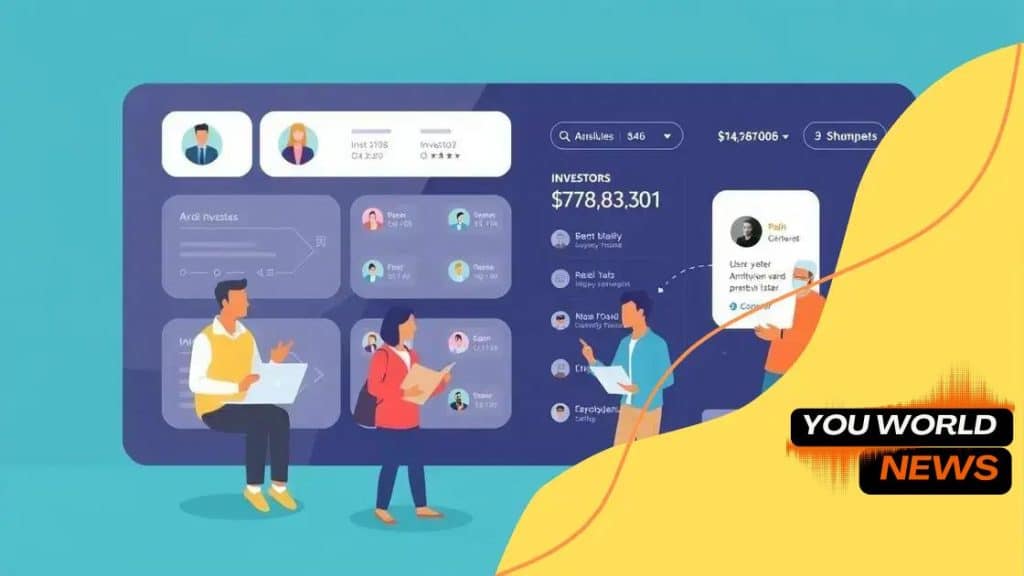Peer-to-peer lending platforms and their future growth

Peer-to-peer lending platforms connect borrowers directly with investors, offering lower interest rates for loans, higher returns for investors, and faster access to funds while facing challenges like risk management and regulatory compliance.
Peer-to-peer lending platforms are reshaping the financial landscape by providing alternative borrowing and investment options. Have you wondered how these platforms could transform your approach to finance?
Understanding peer-to-peer lending
Understanding peer-to-peer lending is essential in today’s financial world. This innovative system connects borrowers directly to investors, allowing individuals to lend and borrow money without traditional banks.
Peer-to-peer lending platforms offer various advantages for both parties. They often provide loans at lower rates than banks and can be a quick way to secure financing. For investors, these platforms can yield higher returns than traditional investment options.
How Peer-to-Peer Lending Works
In peer-to-peer lending, individuals list their requests for loans on platforms where others can view them. Investors can choose to fund these requests in amounts they feel comfortable with. The platform typically handles the transaction, collecting and distributing payments.
Benefits of Peer-to-Peer Lending
- Lower interest rates: Peer-to-peer loans often carry lower rates compared to traditional bank loans.
- Accessibility: Borrowers may find it easier to qualify for loans through these platforms.
- Diverse investment opportunities: Investors can choose from a variety of loans based on their risk tolerance.
Peer-to-peer lending is reshaping how individuals think of borrowing and investing. With this system, people can leverage technology to make financial transactions easier and more transparent. It also fosters a sense of community, as individuals can support one another through lending.
As the market evolves, more consumers are realizing the potential benefits of engaging with peer-to-peer lending platforms. They can match their needs with available funds quickly. Whether it’s a personal loan or an opportunity for investors, understanding this system is crucial for navigating financial possibilities.
Key benefits for borrowers and investors
Key benefits for borrowers and investors in peer-to-peer lending platforms highlight the opportunities and advantages that this innovative system provides. For borrowers, these platforms often offer easier access to funds with faster approval times. The process is usually streamlined, allowing individuals to navigate their loan options without the long waits often found in traditional banking.
On the other hand, investors are drawn to peer-to-peer lending due to the attractive potential returns. By providing loans directly to borrowers, investors have the chance to earn higher interest rates than traditional savings accounts.
Benefits for Borrowers
- Lower interest rates: Compared to banks, many peer-to-peer platforms offer lower rates, making borrowing more affordable.
- Flexible terms: Borrowers can often choose terms that better suit their financial situation.
- Quick access: The application process tends to be faster, ensuring that funds are available when needed.
Additionally, borrowers have the ability to use funds for various purposes, such as consolidating debt or funding a home improvement project. This flexibility can be crucial for those needing immediate financial help.
Benefits for Investors
- Diversified portfolio: Investors can spread their investments across multiple loans to mitigate risk.
- Higher returns: Investing in peer-to-peer loans often yields greater returns compared to conventional investments.
- Direct impact: Investors can choose loans that align with their values, knowing they are helping individuals achieve their financial goals.
Ultimately, both borrowers and investors can find value in the peer-to-peer lending model. The direct interaction creates a unique relationship, fostering a sense of community and support in financial transactions. As this model continues to grow, understanding these key benefits will become increasingly important.
Market trends influencing growth

Market trends influencing growth in peer-to-peer lending are shaping how this industry evolves. With technological advancements and changing consumer behaviors, these trends continually impact both borrowers and investors.
One significant trend is the rise of digital platforms. As technology advances, more individuals turn to online solutions for their lending needs. This shift is making peer-to-peer platforms more accessible and user-friendly.
Increased Regulation
Regulatory changes can also influence market growth. As governments worldwide recognize the potential of peer-to-peer lending, they offer guidelines to protect consumers and ensure the industry remains transparent. This increase in regulation can boost confidence among users, leading to higher participation rates.
Growing Awareness
- Informed Consumers: Awareness campaigns and information sharing have made more people aware of peer-to-peer lending.
- Word of Mouth: Positive experiences shared by users encourage new participants to engage with these platforms.
- Interest in Alternatives: Individuals are increasingly seeking alternative lending options rather than traditional banking.
Moreover, economic factors such as interest rates and employment rates play a crucial role in the demand for peer-to-peer lending. When traditional lending options become less favorable, more people seek alternative solutions. This creates an environment where peer-to-peer lending can thrive.
The demand for personalized services also drives growth. Peer-to-peer platforms are increasingly offering tailored products and services that meet the unique needs of borrowers. This customization can attract more users to the platform.
Challenges faced by lending platforms
Challenges faced by lending platforms in the peer-to-peer lending industry can significantly impact their growth and sustainability. Despite the many benefits they offer, these platforms encounter obstacles that can affect both borrowers and investors.
One major challenge is managing risk. Every loan carries an inherent risk of default, which can lead to financial losses for investors. Platforms must implement strict measures to assess a borrower’s creditworthiness to minimize these risks. This often includes thorough credit checks and income verification.
Regulatory Compliance
Another challenge is staying compliant with regulations. As the peer-to-peer lending market grows, so too does the scrutiny from financial regulators. Platforms must navigate complex laws and ensure they adhere to all guidelines. This compliance can be costly and time-consuming.
Market Competition
- Growing number of platforms: As more players enter the market, competition becomes fierce.
- Pressure on fees: Increased competition can lead to lower fees, which might hurt a platform’s profitability.
- Attracting users: With so many options, platforms need effective marketing strategies to attract both borrowers and investors.
Additionally, maintaining trust is vital. As fraud cases arise in the financial industry, lending platforms must ensure their security measures are robust. This involves educating users about online safety and protecting personal data, as any breach can damage their reputation.
Another issue is the cyclical nature of the economy. In tough economic times, borrowers may struggle to repay loans, leading to higher default rates. Platforms must be prepared for such fluctuations and adapt their lending strategies accordingly.
The future outlook for peer-to-peer lending
The future outlook for peer-to-peer lending appears promising as the industry continues to adapt to changing financial landscapes. With increasing technology integration and consumer demand for alternative lending solutions, these platforms are likely to grow significantly.
Technological advancements play a key role in shaping this future. As AI and data analysis become more prevalent, platforms can better assess borrower risk and automate processes. This not only increases efficiency but also enhances the user experience for both borrowers and investors.
Expansion into New Markets
Peer-to-peer lending is also expected to expand into new markets. More people globally are recognizing the benefits of this financial service. As it gains acceptance in emerging markets, the number of users and available capital is likely to rise.
Increased Regulation and Security
- Enhanced Security: As more platforms emerge, the need for robust security measures will grow, ensuring user trust.
- Stricter Regulations: Governments may implement regulations to protect consumers, leading to a more stable market.
- Transparency in Operations: Greater emphasis on transparency will benefit both borrowers and lenders, fostering trust.
Consumer behavior is also changing, with many individuals seeking more personalized financial solutions. Peer-to-peer lending offers tailored options, allowing users to find terms that suit their needs. This shift toward customization will likely attract more participants.
As more people gain financial literacy, they will understand the advantages of peer-to-peer lending over traditional methods. This growing awareness can fuel continued interest and participation in the market.
FAQ – Frequently Asked Questions about Peer-to-Peer Lending
What is peer-to-peer lending?
Peer-to-peer lending is a method that connects borrowers directly with individual investors through online platforms, bypassing traditional banks.
What are the benefits of using peer-to-peer lending?
Benefits include lower interest rates for borrowers, higher returns for investors, faster access to funds, and personalized loan options.
What challenges do peer-to-peer lending platforms face?
Challenges include managing risk, regulatory compliance, market competition, and maintaining user trust and security.
How do technology and regulation impact the future of peer-to-peer lending?
Technological advancements enhance efficiency and user experience, while increased regulation can improve security and consumer trust in the market.





